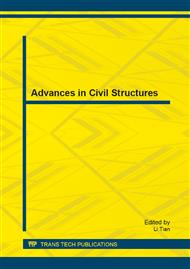p.1669
p.1673
p.1677
p.1683
p.1687
p.1694
p.1700
p.1706
p.1710
Effect of Curing Temperature on the Properties of Concrete at Early Age
Abstract:
Under the consideration of radiation, convection, and evaporative cooling, simulating the effect of different curing temperatures (5°C,10°C,15°C,20°C,25°C,30°C) on the performance of concrete at early age. The results showed that curing temperature affected the early age performance of concrete greatly. Higher curing temperature improves the peak temperature of concrete members, and contributes to the development of the strength of concrete at early age, but elevated curing temperature will lead to higher cracking potential classification of concrete at early age.
Info:
Periodical:
Pages:
1687-1693
Citation:
Online since:
August 2013
Authors:
Keywords:
Price:
Сopyright:
© 2013 Trans Tech Publications Ltd. All Rights Reserved
Share:
Citation:


